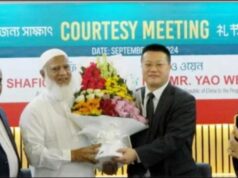The current standoff between Indian and Chinese troops along the Line of Actual Control (LAC) in Eastern Ladakh is four years old. At the height of Covid-19, Chinese and Indian troops clashed in Galwan Valley, leading to fatalities on both sides. That episode brought about a dramatic change in India’s approach to border security and the need to ramp up border infrastructure. Four years later, India is better prepared, thanks to untiring efforts by the Border Roads Organisation (BRO).
Galwan was a trigger for infrastructure acceleration on the border; it helped us in understanding the dynamics of infrastructure, especially in Eastern Ladakh and Arunachal Pradesh, says Lt Gen Rajeev Chaudhry (Retd) who was then Director General of BRO. The BRO was under a lot of pressure to increase road connectivity to the last mile. Also, nearly all the Casual Paid Labourers (CPLs) that we employ had gone back to their native places due to Covid (70% of them are from Dumka in Jharkhand), he told StratNews Global Editor-in-Chief Nitin A. Gokhale.
The Funds Factor
When the current government took over, the BRO budget stood at ₹2000 crore. Irregular flow of funds meant cost and time overruns due to which projects got delayed. We had a lot of interactions with various stakeholders including the finance ministry, National Security Council Secretariat, pressing for more funds. And since 2021-22, the BRO budget for Army roads has been hiked by 40 per cent every year, which is incredible, says Lt Gen Chaudhry (Retd).
New Technology
The BRO had been using primitive technology for constructing roads, tunnels and bridges. A review was done and a decision taken that new technology will be used. For example, steel slag (a byproduct in the steel manufacturing process) was used in place of aggregates in making roads. Plastic waste was shredded and mixed with bitumen, which made the roads impervious and less prone to being damaged during the monsoons, especially in the Northeast. New and indigenous machines were procured that made the job faster and cheaper in the long run.
Strengthening Bridges
A lot of Bailey bridges that existed in the Northeast were susceptible to damage during monsoon flooding. Besides, they were not strong enough to stand the weight of heavy tanks, artillery guns and multi-axle loaded trucks. The BRO then made it a policy to make all bridges in forward areas Class 70 (which is strong enough to withstand heavy armaments). The first Class 70 double lane modular bridge was built at Flag Hill in Dokala, Sikkim. These bridges are as good as permanent bridges, can be launched in a week and are far cheaper than the imported ones, says Lt Gen Chaudhry (Retd). BRO is the only agency in the country to have done the structural audit of all its bridges (908) and roads, he adds.
Culverts
Four culverts per kilometre is generally the norm in hilly terrains. It used to take three-four months to build onsite and each used to cost about ₹34 lakh. This was replaced with a prefabricated cheaper version costing about ₹23 lakh apiece and was put in place with the help of cranes.
Pre-execution Stage
All new policies have been institutionalised, so are automatically part of any new project. Detailed project reports are now made using Lidar (Light Detection and Ranging) and drones, unlike manually earlier when ground surveys were done to mark road alignments. BRO has asked for a dedicated satellite and is hopeful it will happen soon, says Lt Gen Chaudhry (Retd).
Caring For The Workforce
The BRO employs about 90,000 people as CPL. At each location, about 30 per cent of the workforce is drawn from the local population. There has been a concerted effort to raise their standard of living. About 70 per cent of the work the BRO does happens at altitudes above 14,000 feet, at sub-zero temperatures. So centrally heated accommodation and personal gear like jackets, goggles and shoes were made available to the labourers. Also, a term insurance coverage of ₹10 lakh was introduced. BRO’s work was publicised to make it visible and let people know about the agency and the tough terrain it operates in. Decision making which was sluggish earlier and at times used to cost a working season was made faster.
World’s Highest Road
The BRO is currently working on a strategic 64-km Likaru-Mig La-Fukche road in Eastern Ladakh, which will give troops faster access to forward areas. When complete, this will be the world’s highest motorable road, at 19.400 feet. It will dwarf the record currently held by the road at Umling La (19,024 feet).
Tunnels
Till the Galwan clash, the BRO had constructed four tunnels. It is currently working on 10 tunnels and eight tunnels are in the pipeline. We had a regressive thinking that tunnels are not required, they are costly but tunnels are the future of connectivity, faster all-weather connectivity in the mountains, says Lt Gen Chaudhry (Retd). Some of the tunnels that are going to come up soon are even higher than the one in Mont Blanc in the Alps. Tunneling through the Himalayas is tough, compared to the Alps that are stable and sturdier mountain ranges.
Airfields
The BRO recently completed the airfields at Bagdogra and Barrackpore, giving a fillip to the Eastern Air Command. The airfield at Nyoma (13,700 feet), which is expected to be completed next year, will be the world’s highest fighter airbase and be used for civilian purposes as well.
Nitin A. Gokhale is a media entrepreneur, one of South Asia's leading strategic affairs analyst and author of over a dozen books so far on military history, insurgencies and wars.
Starting his career in journalism in 1983, he has since led teams of journalists across media platforms.
A specialist in conflict coverage, Gokhale has covered the insurgencies in India’s North-East, the 1999 Kargil conflict and Sri Lanka’s Eelam War IV between 2006-2009.
Gokhale now travels across the globe to speak at seminars and conferences, and lecture at India’s premier defence colleges. He has founded three niche portals, Bharatshakti.in, stratnewsglobal.com and Interstellar.news.




